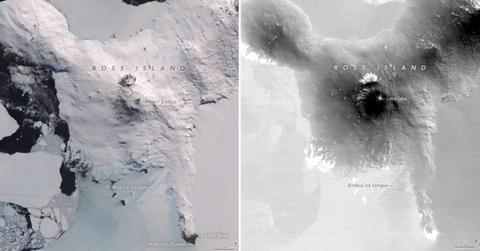Frosty Fortune: Active Volcano in Antarctica Spewing Gold

Satellite images of Mount Erebus from 2013, including the lava lake at its center.
In the realm of Antarctica, amidst its icy expanse, there exists a phenomenon similar to a fantastical tale — a cascade of gold descending from the heavens.
Nestled among the glaciers lies Mount Erebus, a fiery sentinel and the southernmost active volcano on Earth.
A study conducted in 2017 unveiled the presence of 138 volcanoes dotting this frozen continent, with approximately nine among them marked as active. Towering at a summit elevation of 12,448 feet, Mount Erebus reigns as the most prominent among them.
Part of the three volcanoes forming Ross Island, Erebus earned its name from its fiery temperament, believed to be in the throes of eruption when first sighted in 1841 during Captain James Clark Ross's pioneering expedition, UPI reported.
Ross, renowned for his magnetic surveys in both Arctic and Antarctic realms, christened the Ross Sea and unveiled the Victoria Land region. The vessel 'HMS Erebus' was a notable companion on his exploratory journey.
Even in modern times, scientists maintain a vigilant watch over the volcano through the Mount Erebus Volcano Observatory, engaging in field expeditions to uncover extremophilic life forms.
- What Lies Beneath: NASA Scientist Believes Aliens May Have Found 'Perfect' Hiding Spot in Earth's Oceans
- Global Threat: Russia Insider Warns West of 'World War Using Nuclear Weapons' Amid Escalating Support for Ukraine
- Countdown to Disaster? Ex-NATO Official Warns Russia, Iran and China Could Wage WWIII in Just Years
Notably, the largest Antarctic settlement, McMurdo Station, administered by the United States, lies approximately 25 miles south of Mount Erebus, offering a unique vantage point to observe its fiery displays.
Satellite imagery of Erebus reveals a persistent lava lake, its fiery cauldron bubbling since at least 1972, as reported by IFL Science.
Never miss a story — sign up for the Front Page Detectives newsletter. Be on the scene the moment news breaks.
The volcano sporadically emits plumes of gas and steam, occasionally launching boulders of semi-molten rock known as "volcanic bombs" into the air.
While the spectacle of volcanic bombs is captivating, it is the unexpected phenomenon of gas eruptions dispersing minuscule metallic gold crystals that perplex scientists. Estimates suggest that Mount Erebus expels approximately 80 grams of gold per day — a fortune amounting to roughly $6,000.
Remarkably, traces of this gold dust have been detected hundreds of miles away from Mount Erebus, suspended in the ambient air by Antarctic researchers as far as 621 miles from the volcano's epicenter.
Become a Front Page Detective
Sign up to receive breaking
Front Page Detectives
news and exclusive investigations.
